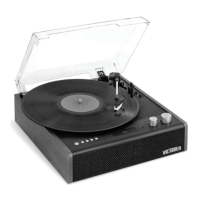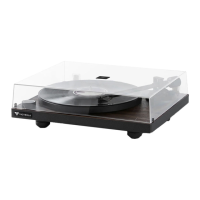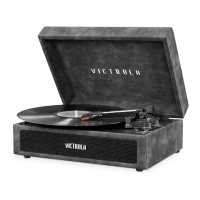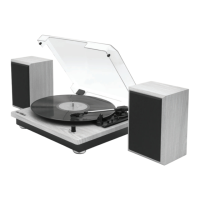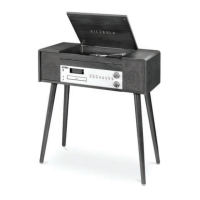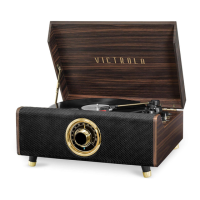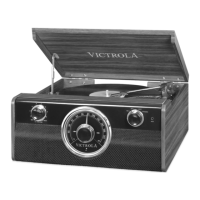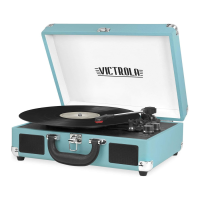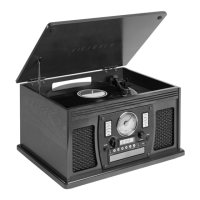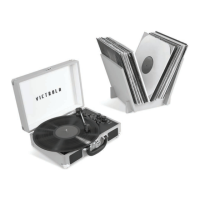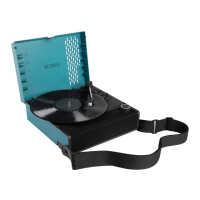How to fix decline in Victrola BROOKLINE Turntable audio performance?
- DDonald JuarezSep 8, 2025
If you notice a decline in your Victrola Turntable's audio performance, the turntable stylus may be worn out. Consider replacing the stylus.
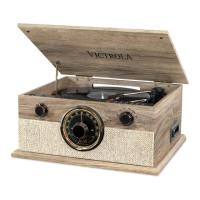
How to fix decline in Victrola BROOKLINE Turntable audio performance?
If you notice a decline in your Victrola Turntable's audio performance, the turntable stylus may be worn out. Consider replacing the stylus.
Why does my Victrola Turntable CD stop immediately after starting?
If your Victrola Turntable's CD stops immediately after starting, or pauses/stops during play, check if the CD is inserted upside down. If so, insert the CD with the printed side right-side up. Also, the CD might be dusty, dirty, or have condensation on it. Carefully clean and dry the CD.
Why won't the CD tray open on my Victrola BROOKLINE?
If the CD tray on your Victrola Turntable won't open, check to see if FM/BLUETOOTH/AUX/PHONO/ TAPE mode is selected. If it is, select CD mode.
What to do if the tape does not play on my Victrola BROOKLINE?
If the tape doesn't play on your Victrola Turntable, make sure the cassette tape is inserted correctly. If it is, the tape may have reached the end; try flipping the cassette.
| Drive Type | Belt Drive |
|---|---|
| Built-in Speakers | Yes |
| Bluetooth | Yes |
| USB Output | Yes |
| Dimensions | 15.75 x 12.79 x 5.11 inches |
| Weight | 7.72 lbs |
| Connectivity | Bluetooth, RCA, USB |
| Outputs | RCA, USB |
| USB Recording | Yes |
| Type | Belt Drive |
| Speed | 33 1/3, 45 RPM |
| Cartridge | Moving Magnet |
| Color | Black |
Turns the unit on or off.
Connect headphones for private listening.
Connect external audio sources via AUX.
Open and close the CD disc tray.
Pair, disconnect, and reconnect Bluetooth devices.
Controls for Program, Repeat, Shuffle, and Intro playback.
Adjust bass levels for audio output.
Play, Pause, Stop, Next, and Previous track controls.
Fast rewind and forward playback for CD mode.
Adjust volume and tune radio stations.
Select desired playback function (FM, CD, BT, etc.).
Displays current mode and track information.
Access the CD tray and eject cassette tapes.
Connect FM antenna and external audio devices via RCA.
Connect the unit to a wall outlet for power.
Identifies turntable, speed selector, tone arm, stylus, and accessories.
Steps for initial setup, including needle cover removal and power connection.
Turning the unit on/off, mode selection, and volume adjustment.
Connect an external amplifier using RCA cables for audio output.
Connect headphones for private listening and adjust volume control.
How to select FM mode and tune into radio stations.
Loading, playing, and pausing CDs or CD-RWs.
Skipping tracks, fast forward/rewind, and stopping playback.
Options for repeating single tracks or the entire CD.
Playing tracks in a random sequence and cancelling shuffle mode.
Creating custom playback sequences of up to 20 tracks.
Pairing the unit with external Bluetooth devices for audio streaming.
Information on the PAIR button and fast forward/rewind limitations.
Connecting external devices using a 3.5mm cable to the AUX-IN jack.
Steps for playing vinyl records, including speed selection and tonearm operation.
Important tips for handling and storing vinyl records to prevent damage.
Instructions for loading, playing, fast-forwarding, and ejecting cassette tapes.
Guidelines for handling, cleaning, and storing CDs to ensure longevity.
Best practices for touching, cleaning, and storing vinyl records to maintain quality.
Advice on unplugging, cleaning, and storing the unit safely.
Step-by-step guide for safely removing and installing a new turntable stylus.
Power requirements, consumption, dimensions, and weight.
Output power and frequency response of the amplifier.
Speaker type, impedance, and input power.
Frequency range for FM radio reception.
Frequency response and signal-to-noise ratio for CD playback.
Track system, tape speed, wow/flutter, and frequency response.
Motor type, drive system, speeds, S/N ratio, and cartridge type.
Bluetooth version, profiles, frequency range, and operating distance.
Troubleshooting for power, sound output, and unit response.
Solutions for tape not playing or poor signal reception.
Troubleshooting for distorted sound, playback errors, and tray issues.
Resolving issues with AUX mode, Bluetooth pairing, and sound quality.
FCC rules for device operation and interference.
Compliance with Industry Canada's license-exempt RSS standards.
Warning regarding potential exposure to chemicals like lead.
Coverage for defects, period, and exclusions.
Procedure for requesting RMA, returns, and contact information.
Exclusions, implied warranties, and consumer legal rights.
